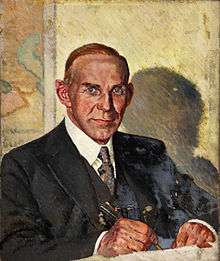Roundell Palmer, 3rd Earl of Selborne
| The Right Honourable The Earl of Selborne CH PC | |
|---|---|
 Portrait of Roundell Palmer commissioned by the Ministry of Information in the World War II period | |
| Parliamentary Secretary to the Board of Trade | |
|
In office 1922–1924 | |
| Monarch | George V |
| Preceded by | William Mitchell-Thomson |
| Succeeded by | A. V. Alexander |
| Minister of Economic Warfare | |
|
In office 1942–1945 | |
| Preceded by | Hugh Dalton |
| Succeeded by | Lord Lovat |
| Personal details | |
| Born | 15 April 1887 |
| Died | 3 September 1971 (aged 84) |
Roundell Cecil Palmer, 3rd Earl of Selborne, CH, PC (15 April 1887 – 3 September 1971), styled Viscount Wolmer from 1895 to 1941, was a British administrator, intelligence officer and Conservative politician.
Background and education
Born in the City of Westminster, Wolmer was the eldest son of William Palmer, 2nd Earl of Selborne and his wife, the former Lady Beatrix Cecil, daughter of Robert Cecil, 3rd Marquess of Salisbury. He was educated at Winchester College and graduated from University College, Oxford in 1909.
Political career
A few months later, at the December 1910 general election Lord Wolmer entered Parliament as Member of Parliament (MP) for the Newton division of Lancashire. He was Parliamentary Private Secretary to his uncle, the Parliamentary Under-Secretary of State for Foreign Affairs, Lord Robert Cecil in 1916 and Assistant Director of the War Trade Department from 1916 to 1918. At the 1918 general election, he did not stand in Newton (which was won by the Labour Party politician, Robert Young), but was elected to the newly formed constituency of Aldershot that year. From 1922 to 1924, he was Parliamentary Secretary to the Board of Trade and Assistant Postmaster-General from 1924 to 1929.
In 1940, Lord Wolmer left the Commons when he was called up the House of Lords in his father's barony of Selborne and was Director of Cement at the Ministry of Works from 1940 to 1942. In 1942, he inherited his father's earldom and his last political post was as Minister of Economic Warfare from 1942 to 1945. This put him in charge of the Special Operations Executive, which ran undercover operations of sabotage in Occupied Europe. He was made a member of the Order of the Companions of Honour after the war and in 1948 was Master of the Worshipful Company of Mercers, then chairman of the National Provincial Bank from 1951 to 1953 and deputy chairman of Boots from 1951 to 1964.
Family
On 9 June 1910, he married the Honourable Grace Ridley, third daughter of Matthew White Ridley, 1st Viscount Ridley. They had six surviving children:
- Lady Anne Beatrice Mary (1911–2002), married the Reverend John Brewis.
- William Matthew Palmer, Viscount Wolmer (1912–1942).
- Lady Laura Mary (1915–1999), married Cyril Eastaugh, Bishop of Peterborough.
- Hon. Robert Jocelyn (1919–1991), married Anne Palmer, 11th Baroness Lucas.
- Lady Mary Sophia (1920–2001), Hon. Anthony Strachey, son of Maurice Towneley-O'Hagan, 3rd Baron O'Hagan.
- Hon. Edward Roundell (1926–1974), married Joanna Bacon (a daughter of Sir Edmund Bacon, Bt).
Lord Selborne's wife died in 1959 and on 3 March 1966, he married Valerie Bevan née de Thomkahaza, a daughter of a Hungarian politician. His eldest son had also died on active service in 1942 and upon his own death in 1971 in Alton, Hampshire aged 84, was succeeded in his titles by his grandson, John.
References
External links
- Hansard 1803–2005: contributions in Parliament by the Earl of Selborne
| Parliament of the United Kingdom | ||
|---|---|---|
| Preceded by James Seddon |
Member of Parliament for Newton Dec 1910 – 1918 |
Succeeded by Robert Young |
| New constituency | Member of Parliament for Aldershot 1918–1940 |
Succeeded by Oliver Lyttelton |
| Political offices | ||
| Preceded by William Mitchell-Thomson |
Parliamentary Secretary to the Board of Trade 1922–1924 |
Succeeded by A. V. Alexander |
| Preceded by Hugh Dalton |
Minister of Economic Warfare 1942–1945 |
Succeeded by Lord Lovat |
| Peerage of the United Kingdom | ||
| Preceded by William Palmer |
Earl of Selborne 1942–1971 |
Succeeded by John Palmer |
| Baron Selborne (writ of acceleration) 1940–1971 | ||